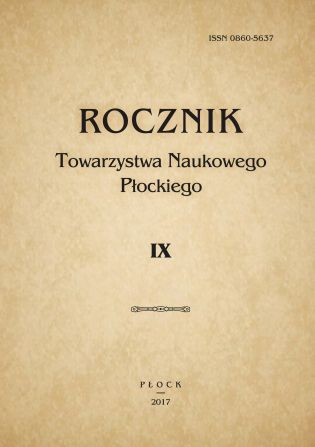Życie gospodarcze i kulturalne w powiecie gostynińskim w okresie międzywojennym (1918-1939) / The economic and cultural life in Gostynin district during the interwar period (1918-1939)
Abstract
Streszczenie:
Ludność powiatu gostynińskiego, jego miast i wsi z ogromnym zadowoleniem przyjęła odzyskanie przez Polskę niepodległości w listopadzie 1918 roku. Serdecznie witano w Gostyninie 10 kwietnia 1921 r. twórcę niepodległości Polski Józefa Piłsudskiego jadącego do Płocka na uroczystości odznaczenia tego Miasta Krzyżem Walecznych. Autor opracowania na podstawie materiałów źródłowych, opracowań historycznych, a także prasy regionalnej stara się przedstawić rozwój gospodarczy powiatu gostynińskiego w okresie międzywojennym (1918-1939), a także rozwój szkolnictwa i życia kulturalnego.
Wielkim wydarzeniem w życiu powiatu było wybudowanie linii kolejowej łączącej Kutno z Gostyninem i Radziwiem. Stało się to w latach 1919-1925. Kolejowe połączenie Gostynina z Kutnem ułatwiało kontakt mieszkańców Gostynina z Warszawą, Łodzią, a także Poznaniem. Negatywny wpływ na życie gospodarcze powiatu, jak i całego kraju miał wielki kryzys gospodarczy w latach 1929-1933. Wzrosło wówczas bezrobocie i pogłębiła się bieda wśród mieszkańców powiatu. W 1933 r. została zlikwidowana papiernia w Soczewce. Pracę straciło kilkuset pracowników. Mimo to badacze regionu gostynińskiego pozytywnie oceniają zmiany w życiu gospodarczym powiatu w okresie międzywojennym, tj. 1918-1939. Według Józefa Kazimierskiego, współautora monografii „Dzieje Gostynina i ziemi gostynińskiej" wydanej w 1990 r., lata 1918-1939 można uznać za pomyślne dla rozwoju Gostynina, jak również dla Gąbina, a lata 1935-1939 wręcz za okres przyspieszonego rozwoju.
Słowa kluczowe: powiat gostyniński, władze powiatu, miast i gmin, ludność powiatu, wyznania religijne, partie polityczne, życie gospodarcze, parcelacja majątków, komasacja, inwestycje w miastach i gminach, otwarcie kolei Kutno - Gostynin - Radziwie, stan oświaty i kultury.
Summary: Population of the Gostynin district, including its towns and villages, accepted the reclaimation of independence with utmost satisfaction by Poland in November 1918. The creator of the Polish independence, Józef Piłsudski, who was driving to Płock for the ceremony of awarding that town the Distinguished Service Cross, was warmly welcomed in Gostynin on l0th April 1921.The Author of the study, based on source materials, historical studies and regional press, aims at presenting the economic, educational and cultural development of the Gostynin district during the interwar period (1918-1939).
A great event in the district's life was building a railway line joining Kutno with Gostynin and Radziwie. It took place between years of 1919 and 1925. The train connection between Gostynin and Kutno made an easy contact for Gostynin inhabitants with Warsaw, Łódź and Poznań. A negative influence, not only on the district's economic life, but also on the whole country, had large economic crisis in 1929-1933. At that time unemployment and poverty among the district's inhabitants increased. In 1933 a paper mill in Soczewka was liquidated and due to it a few hundred workers lost their jobs. In spite of that researchers of the Gostynin region are positively assessing changes in the district's economic life during the interwar period 1918-1939. According to Józef Kazimierski, an coauthor of „The Gostynin and its Region Story" monograph being issued in 1990, the period 1918-1939 could be regarded as the favorable one for development of both Gostynin and Gąbin and the period 1935-1939 as the period of the accelerated expansion.
Keywords: Gostynin district, town and commune authorities of a district, authorities of towns and communes, district population, religion, political parties, economic life, lotting of properties, aggregation, investments in towns and communes, opening the Kutno -Gostynin - Radziwie railroad, condition of education and culture.
